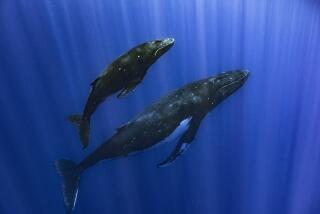‘Humpback Whales 3-D’ a labor of love for documentary filmmakers
How do you film a humpback whale?
Veteran large-format filmmaker Greg MacGillivray admitted he didn’t have a clue when he set out to make the new IMAX 3-D film “Humpback Whales 3-D,” which opens Friday at the California Science Center.
The 50-foot-long, 50-ton mammals aren’t actually camera shy, but they spend 95% of their time under water. And when you’re working with 200-pound IMAX cameras that shoot only three minutes of film, the prospect is daunting.
“We had to basically figure it out by talking to scientists,” said MacGillivray. “How long does an animal stay stationary? If you jump into the water next to a whale, it can instantly swim away. We never really even knew we would be able to get great shots from a helicopter or underwater.”
Suffice it to say, the film, narrated by Ewan McGregor, was a real labor of love.
“It took us seven years to make,” said the filmmaker’s son, producer Shaun MacGillivray. “We spent three years in pre-production and development, and we were out in the field for three years. We went to Tonga, Alaska and Hawaii.”
MacGillivray Freeman Films has made more than 38 IMAX movies on various subjects, but the company’s greatest passion is “to inspire people to care about the ocean,” noted Shaun MacGillivray. (Their documentary shorts “The Living Sea” (1995) and 2000’s “Dolphins” were nominated for Academy Awards.)
“We had never made a filmon whales or humpback whales,” saidShaun MacGillivray. “We felt this was a great opportunity to tell a story.”
The humpback was nearly wiped off the planet due to whaling. “They think there might have been 250,000 before whaling began, and then the population got down to really low numbers like 20,000 or less,” said Greg MacGillivray. “But with protective rulings from the International Whaling Commission, I think it’s back to above 100,000.”
The director noted that many of MacGillivray Freeman’s environmentally themed films have been troubling. By contrast, the documentary on humpback whales is “kind of a feel-good story.” (The film does address the fact that Japan, Norway and Iceland still are whaling.)
“I think within 10 years, they will discontinue the practice,” said Greg MacGillivray. Whales still are threatened by ship collisions, entanglements,climate change and even noise pollution.
Humpback whales got their name because of the way they arch their backs in preparation for diving. They are found in every ocean and migrate between summer feeding grounds in polar waters and tropical waters for the winter.
Scientist Fred Sharpe, who is featured in the film, has studied the whales for more than 25 years. During the summer, he’s based in Alaska. “I go where they take me, and that includes journeys to Polynesia, where they winter.”
Sharpe’s studied them for so long, he can identify members of the community. “These animals are like his pets,” said Greg MacGillivray. “He knows them by their look and their sounds. He listens to one blow and goes, ‘That’s Judy.’ ”
“We’ve had the good fortune of finding a community of whales that are very social,” said Sharpe. And the film captures this community’s cooperative food-gathering system called “bubble net fishing,” in which the whales work together to entrap vast quantities of herring.
Sharpe’s community consists of two or three dozen whales. “Other whales will come and feed with them,” he said. “Over the years, we have documented hundreds and hundreds of other whales that come for a day, a week or a summer, but they tend to move on. But there is an intimate little core that’s always the same.”
The humpback whales, Sharpe added, have many human-like characteristics. “They are truly compassionate beings. These whales have defended each other from killer whales, and they have been known to help baby seals harassed by predators. They will come and chase the killer whales away.”
The male humpback whales also sing, sometimes up to 20 minutes at a time, which may be some sort of a mating ritual. “They sing with rhyme and syntax,” said Sharpe.
The film captures a courtship around the production’s boat in Hawaii.
“They were chasing each other,” said Greg MacGillivray. . “We got our underwater camera into the water. I called the helicopter cameraman and said, ‘Get over here as fast you can.’ The animals stayed with us for about an hour. The captain said, ‘We have a couple of whales here who are courting each other and are using the boat for some fashion.’ Maybe they were sharing their joy with us.”
For more Classic Hollywood, follow us on Facebook and subscribe to the newsletter
More to Read
Only good movies
Get the Indie Focus newsletter, Mark Olsen's weekly guide to the world of cinema.
You may occasionally receive promotional content from the Los Angeles Times.







